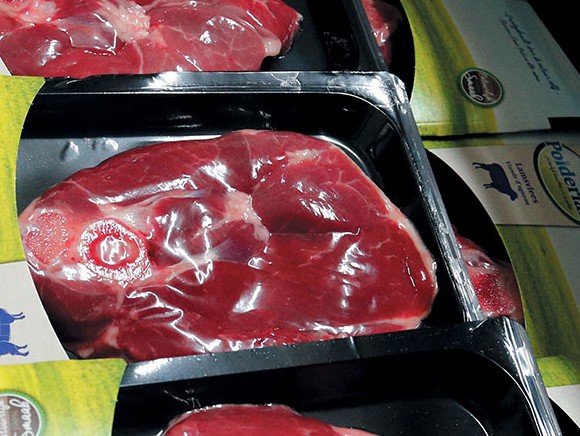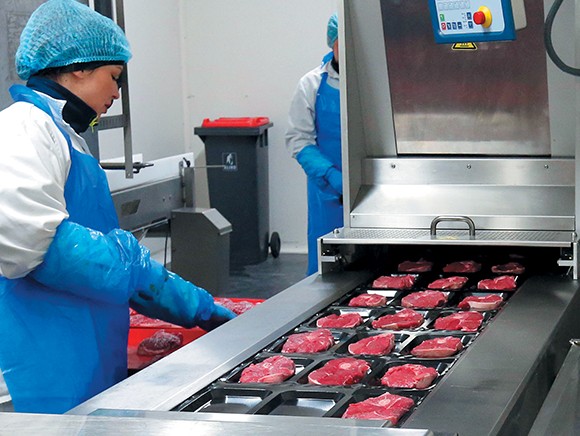
The company Polderlam in Deurne processes Dutch lamb into refrigerated retail and foodservice products. The meat is vacuum-packed in a skin packaging immediately after cutting. This not only extends the shelf life, but the attractive on-shelf presentation also looks professional and entices shoppers to buy.
The company Vee- en Vleeshandel Van Veen in Zuilichem has been involved in the sheep and lamb business for four generations. It all started a century ago with the purchase of Friesian meadow lambs. Since then the parent company, Vee- en Vleeshandel Van Veen, has gained control of a number of links in the lamb chain. The supplementary feed for the lambs that graze in the Bommelerwaard region is produced in-house. It is made from a mix of maize, grain, sugar beet and aromatic grasses. The lambs are slaughtered when they are six to eight months old. The establishment of the subsidiary Polderlam in Deurne in 2014 marked the addition of the processing of the meat from the lambs Vee- en Vleeshandel Van Veen’s portfolio.
Bas Scheffers, Director at Polderlam, explains that the shelf life and product presentation are two important issues for him. “On-shelf appeal is essential when selling lamb, since it is a niche product – many consumers are unfamiliar with it. We can win new customers by letting people sample it but designing good retail packaging definitely plays a role too.” When choosing a new packaging machine, modified atmosphere packaging (MAP) was immediately rejected because it gives a shelf life of only eight to ten days. “In addition, MAP-packed meat looks less attractive,” he says. That’s why he opted for skin packaging for the lamb cutlets, shanks, steaks, shoulders and shawarma products.
As the name suggests, this packaging covers the product like a second skin. “I saw the technique on the Multivac stand at Anuga and other trade shows. It’s a proven method – the Swiss have been using it for the past 15 years.”
Bas already knew Multivac BV and had had positive experiences with the company. “They have an excellent reputation in the industry and provide good service. I told them what I was looking for. They then set to work and built a MULTIVAC R 570 MultiFresh thermoformer that makes packaging just as we specified.” Robert Ruesen, Key Account Manager at Multivac, explains how it works: “Each cycle, a number of trays are formed from the lower roll of film. An employee places the product to be packed into the trays by hand. In the next stage, the thermoformed trays containing the product come into contact with the upper film in the closed sealing station. There, the upper film is first heated and stretched in a dome-shaped upper sealing section. The empty space between the tray containing the product and the stretched upper film is placed under vacuum. When the system is brought to atmospheric pressure the film is draped tightly over the product. The packaging material follows the contours of the meat precisely and seamlessly adheres to the tray all the way round the product, with the clear film looking like a second skin.”
Bas: “This packaging method more than doubles the shelf life of the meat, so we can create a stock buffer and eliminate peaks from the production process. Another positive effect is that the lamb continues to mature in the pack but the colour of the product doesn’t change – the meat retains an attractive, fresh appearance. Moreover, there is much less moisture loss. All this is beneficial for the quality.” Bas is sure that the product presentation has contributed to the sales growth and increase in recognition for the Polderlam products, which are not only sold under private label and the company’s own brand through the retail channel but also to foodservice customers.

“Multivac doesn’t only supply machines. We can also source films from them,” states Bas. “They sell them at competitive prices. The MultiFreshTM skin film is perfectly adapted to the machine for optimal performance.” Furthermore, Bas now has a single point of contact, should there be any problem with either the machine or the film. The packaging machine has been running five days a week since 2014. “Without any problems or mechanical faults. The only thing I need now is an extra valve in relation to the drainage water, but that hasn’t got anything to do with the packaging technology.” The machine supplier immediately takes a look. Robert: “We’ll definitely be able to solve that.”
Source: © Bert Jansen